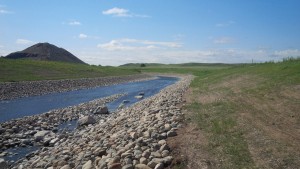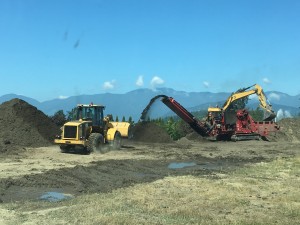10 Tips to Prevent Erosion During Construction
In the U.S., the Department of Agriculture estimates that one billion tons of topsoil are lost to erosion every year. That's about the weight of 2595 large excavators!! Not only does erosion take away precious topsoil, but also clogs waterways and damages adjacent properties.
What can you do to prevent erosion on your projects? The solution can be quite easy or difficult, depending on the site and the safety measures you choose to implement. You might have to be creative. Use these tips to get started.
- Water, along with wind, is a primary agent of erosion. Water always runs downhill; however, it will push uphill when the volume of water flooding an area moves the water out of its banks and up into higher ground. Before beginning construction, make a plan to divert or slow the movement of water. If you able to observe the site pre-construction during a rainstorm it could help in developing the best plan of attack for the project.

- Observe the construction site's slopes for any potential problems. Notice where there could be affected areas adjacent to the site and plan accordingly.
- Disturb as little area as possible. Try to excavate only one section of the site at a time. Yes, it can be more expensive to mobilize and demobilize an excavator a number of different times, but the cost of remediation caused by excess sediment and erosion of the hillside could potentially be so much more than the savings getting it done quicker. Not to mention the potential costs associated with fines.
- Once excavation of an area is complete, try to seed it as soon as possible to create ground cover and minimize erosion. The faster you can get the seed and roots growing, the less erosion. Check with the landscaper or landscape architect to see if they have specifications for seed species. Work this into your excavation schedule to help show due diligence and proper site planning practices.
- For time and labour savings, try Terraseeding, applied by Express Blower truck. Hydroseeding can work on some slopes, but is not effective on slopes greater than 4:1. Terraseeding is the process of installing soil or compost with a blower truck - injecting seed, fertilizer (and tackifier if needed) right into the material as it's blown in. This one step process saves time, labour, and has excellent germination rates.
- Plastic sheeting to shield the soil from rain can be effective in small, erodible areas only. Don't use it in large areas as it can actually do more damage once the water runs off of the cover.

- If you're removing trees from the jobsite, consider bringing onsite a mobile grinder to chip/mulch the material. The ground up material can be used to aid in erosion control. The ground material can be used for erosion control swales or berms, temporary road building or ground cover. You can also compost it onsite to be used at a later date for site slope stabilization, revegetation or blending into the soil for landscaping. It's an easy and cost saving way to prevent having to haul away wood waste.
- Silt fencing or filter sock is commonly used as a sediment control method. Compost filter socks provide a three dimensional filter that retains sediment and other pollutants (e.g., suspended solids, nutrients, and motor oil) while allowing the cleaned water to flow through. FilterSoxx meet or exceed municipal ESC bylaws - specifications & technical data are available upon request for your project documents. If using silt fence, it's important to ensure proper installation for the fence to be effective. Dig a trench and stake in the silt fence. Once upright and tight, backfill the trench with the gravel to help keep it in place.
 You should inspect the fence after each rain storm to check for breaks in the system and for sediment accumulation. Once sediment reaches half the height of the fence, you should remove the sediment. Silt fences can be installed across slopes to help slow water movement and catch sediment. You should not install them across waterways, ditches or other areas with concentrated water flow — these fences were not designed to handle higher water pressure and will fail.
You should inspect the fence after each rain storm to check for breaks in the system and for sediment accumulation. Once sediment reaches half the height of the fence, you should remove the sediment. Silt fences can be installed across slopes to help slow water movement and catch sediment. You should not install them across waterways, ditches or other areas with concentrated water flow — these fences were not designed to handle higher water pressure and will fail. - Straw wattles, which resemble long straw logs, are another means to slow water and catch sediment, and can be more versatile than silt fencing. These must be installed in a trench, as well, and staked and backfilled on the upper side. You should not be able to see daylight under the wattle once installed, and you should turn down the ends slightly to prevent ponding on the back side of the wattle. These are made with either UV resistant netting, which holds for three to five years, or with biodegradable burlap, which lasts approximately one to two seasons. Sometimes a faster & easier alternative can be FilterSoxx in short sections - supplied pre-filled with a natural filtering material.
- You may need to also install erosion control mats or blankets along streamways and ditches to help catch sediment. An alternative to consider is Ecoblanket, a compost erosion control blanket. Add Terraseeding and it's a natural permanent solution. This can help for more long term construction projects as it helps erosion by establishing a buffer for rainfall energy, slows the velocity of water runoff, improves the soil structure and biology of the landscape, and it's easily installed in difficult to reach areas. EcoBlanket is also an excellent product for finishing slopes around a site - a non maintenance natural finish.
Save
Save
These are 10 different suggestions to help you prevent erosion of soil and sediment during your construction projects. It’s a comprehensive list, but hopefully it gives you a head start on controlling erosion during a construction project and protecting unnecessary loss of soil .
Do you have a way of dealing with erosion that isn’t listed above? Let us know. Either comment below or email us your suggestion. Thanks for reading and if you enjoyed it please share it.


